Sunday, May 2, 2010
Privacy Policy
If you require any more information or have any questions about our privacy policy, please feel free to contact us by email at erik.ngablaks@gmail.com.
At http://interiordecoratingschools.blogspot.com/, the privacy of our visitors is of extreme importance to us. This privacy policy document outlines the types of personal information is received and collected by http://interiordecoratingschools.blogspot.com/ and how it is used.
Log Files
Like many other Web sites, http://interiordecoratingschools.blogspot.com/ makes use of log files. The information inside the log files includes internet protocol ( IP ) addresses, type of browser, Internet Service Provider ( ISP ), date/time stamp, referring/exit pages, and number of clicks to analyze trends, administer the site, track user’s movement around the site, and gather demographic information. IP addresses, and other such information are not linked to any information that is personally identifiable.
Cookies and Web Beacons
http://interiordecoratingschools.blogspot.com/ does use cookies to store information about visitors preferences, record user-specific information on which pages the user access or visit, customize Web page content based on visitors browser type or other information that the visitor sends via their browser.
DoubleClick DART Cookie
.:: Google, as a third party vendor, uses cookies to serve ads on http://interiordecoratingschools.blogspot.com/.
.:: Google's use of the DART cookie enables it to serve ads to users based on their visit to http://interiordecoratingschools.blogspot.com/ and other sites on the Internet.
.:: Users may opt out of the use of the DART cookie by visiting the Google ad and content network privacy policy at the following URL - http://www.google.com/privacy_ads.html
Some of our advertising partners may use cookies and web beacons on our site. Our advertising partners include ....
Google Adsense
These third-party ad servers or ad networks use technology to the advertisements and links that appear on http://interiordecoratingschools.blogspot.com/ send directly to your browsers. They automatically receive your IP address when this occurs. Other technologies ( such as cookies, JavaScript, or Web Beacons ) may also be used by the third-party ad networks to measure the effectiveness of their advertisements and / or to personalize the advertising content that you see.
http://interiordecoratingschools.blogspot.com/ has no access to or control over these cookies that are used by third-party advertisers.
You should consult the respective privacy policies of these third-party ad servers for more detailed information on their practices as well as for instructions about how to opt-out of certain practices. http://interiordecoratingschools.blogspot.com/'s privacy policy does not apply to, and we cannot control the activities of, such other advertisers or web sites.
If you wish to disable cookies, you may do so through your individual browser options. More detailed information about cookie management with specific web browsers can be found at the browsers' respective websites.
Monday, April 19, 2010
PSM pistol

The PSM (Pistolet Samozaryadny Malogabaritny, Russian for "small self-loading pistol") was designed by the Tula Design Bureau in 1969 as a self-defense firearm for law enforcement and military officers of the USSR. The pistol entered production at the Izhevsk Mechanical Plant in 1973.
The PSM is a blowback-operated handgun with a double action trigger and slide mounted manual safety without a slide stop. The grip panels are made from thin aluminum and new model with hard plastic. The weapon is made from steel.
The PSM was designed around the newly developed 5.45x18mm cartridge, which was developed for the weapon by Precision Mechanical Engineering Central Research Institute. The cartridge is capable of penetrating 55 layers of kevlar at realistic engagement distances.[citation needed] This cartridge has a bottlenecked case and a spitzer-pointed jacketed bullet, providing performance superior to the .22 LR and .25 ACP (6.35x16mmSR Browning) rounds.
The pistol was primarily intended for army high command staff. However, owing to its insignificant dimensions, especially small thickness (21 mm across the safety catch), it soon became popular with security (KGB) and law enforcement (militsiya) personnel. The PSM was also appreciated by higher echelon Communist Party functionaries.[citation needed]
An export model designated the IZh-75 was produced in .25 ACP.[Revolver mouseguns

Examples of revolver mouseguns include the North American Arms Mini Revolver, which is a spur trigger design with birdshead grips. The North American Arms Mini Revolver is styled very much like popular pocket revolvers of the 19th Century, but is made entirely of stainless steel.
Smith & Wesson's "J-Frame" series of revolvers are a common choice for mouseguns. They are generally more reliable than their automatic counterparts, and offer an exceptional power-to-weight ratio, especially the lightweight AirLite and Airweight lines. On the other hand, they offer only five shots (auto mouseguns often hold more rounds), and have considerably greater recoil, especially in .357 magnum.
mousegun pistol
 A mousegun is most often considered a category of small revolver, or semi-automatic handgun intended for self defense. Typically such small pistols are of .380 ACP (9mm Short) caliber or less, with .32 ACP and .22 Long Rifle calibers also being common. The term is used to describe a class of small handguns. The term is also sometimes used to refer to rifles firing bullets smaller than .30 caliber, such as the .223/5.56mm.
A mousegun is most often considered a category of small revolver, or semi-automatic handgun intended for self defense. Typically such small pistols are of .380 ACP (9mm Short) caliber or less, with .32 ACP and .22 Long Rifle calibers also being common. The term is used to describe a class of small handguns. The term is also sometimes used to refer to rifles firing bullets smaller than .30 caliber, such as the .223/5.56mm.
38-40 Winchester bullet pistol
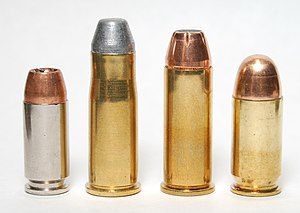 The .38-40 Winchester is a 10 mm cartridge that was introduced by Winchester in 1874 and is derived from their .44-40 Winchester. Though this cartridge was introduced for rifles, it is a better pistol cartridge than rifle cartridge. It is not particularly well suited to hunting game but it is excellent for self defense. Current loadings are intended for pistols[1].
The .38-40 Winchester is a 10 mm cartridge that was introduced by Winchester in 1874 and is derived from their .44-40 Winchester. Though this cartridge was introduced for rifles, it is a better pistol cartridge than rifle cartridge. It is not particularly well suited to hunting game but it is excellent for self defense. Current loadings are intended for pistols[1].
"pistol" and "handgun"

A handgun is a firearm designed to be held and operated by one hand, with the other hand optionally supporting the shooting hand. This characteristic differentiates handguns as a general class of firearms from their larger counterparts: long guns such as rifles and shotguns (which are held in both hands and usually braced against the shoulder), mounted weapons such as machine guns and autocannons, and larger weapons such as artillery.
Beretta 92FS
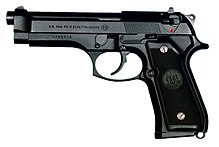
In 1971, Smith & Wesson offered a safe double-action, high-capacity pistol with its Model 59. CZ launched its CZ-75 in 1975. Beretta introduced its Beretta 92 in 1976. Glock introduced the groundbreaking Glock 17 in 1982, and SIG-Sauer introduced its model SIG P226 in 1983. Walther introduced their high capacity P88 in 1988. In the early 90s, Heckler & Koch combined what they thought were the most desirable attributes of semi-autos in their pistol, the HK USP. In 1995, Kel-Tec introduced their first compact 9mm Parabellum pistol, the Kel-Tec P11, designed for concealed carry. In 1999, Kel-Tec introduced their extremely popular .32 ACP P-32 for deeply concealed carry. Both of the Kel-Tec pistols are double-action-only (DAO) designs.
After the Second World War, the almost universal trend has been for self-loading, semi-automatic pistols to replace revolvers for military use, although the transition has been slower among police and civilian use. Today, revolvers are mainly used for civilian self-defense, hunting, plinking, and target practice. Semi-automatic pistols, though, are becoming by far the most popular for deeply concealed carry by licensed civilians, for use as primary handguns for police and military use, for use as backup guns for police use, and for use where the 5 or 6 shots of a revolver are deemed inadequate.
commercial re-creation of Georg Luger's Pistole Parabellum design

The next notable design was the 7.65 mm Luger by Georg Luger, which although successful in its function, nonetheless failed to have adequate stopping power and failed to win widespread acceptance. In 1902, Georg Luger's subsequent and similar 9 mm Luger Parabellum (9 x 19 mm) Pistole Parabellum design overcame the problem of inadequate stopping power and featured a greatly improved Borchardt-type Kniegelenk ("knee-joint") locking mechanism. Unlike Browning's locked-breech design, the barrel in a Kniegelenk design does not tip up and down while the gun is fired, thereby theoretically improving shooting accuracy. Luger's 9mm Pistole Parabellum design was adopted by the German military and served as their standard sidearm during World War I. During World War II, Germany was the first nation to adopt a double-action pistol, the Walther P38 which could be carried loaded (with a cartridge chambered) and ready to fire without the risk of an accidental discharge if dropped. The P38 likewise used Luger's 9 mm Parabellum (9 mm Luger) cartridge.
Hi-Power semi-automatic pistol

After Hiram Maxim introduced his recoil-powered machine gun in 1883, several gunsmiths set out to apply the same principles to handguns, including Maxim. Maxim's designs for smaller firearms using his recoil-powered ideas never went into production. In the 1880s, other designers worked on self-loading designs. The first model to gain any commercial success was the Hugo Borchardt-designed self-loading Borchardt C-93 semi-automatic pistol, which was designed in 1893 and made its public appearance in 1894. Borchardt invented the C-93 mechanism, but it was based in large part upon Maxim's toggle-lock principle. The C-93 featured a clever locking mechanism modeled after the human knee joint in which the mechanical joint is called a knee, or in German Kniegelenk (knee joint).
The C-93 proved mechanically reliable, but was too large and bulky to receive widespread acceptance. Equipped with a screw-on wooden stock, the C-93 served well in small pistol carbines, however. Borchardt also developed the 7.65x25mm Borchardt cartridge, around which the C-93 was built.
In 1896, Paul Mauser introduced his first model of the famous Mauser "Broomhandle" semi-automatic pistol, the C96. Using the powerful 7.63 mm bottle-necked cartridge originally designed by Borchardt, the Mauser was the first self-loading pistol used extensively in battle, notably the South African War of 1899-1902. These pistols were made in 7.63x25mm Mauser along with some models eventually being made in 9 x 19 mm Parabellum (9 x 19 mm Luger) and a small number in .45 ACP.
In the United States in 1896, the first American gun designer to develop self-loading semi-automatic pistols was John Browning, whose models were manufactured by Colt in the US, and by the Belgian firm of Fabrique Nationale (FN) in Europe. Like Luger's work conducted around the same time in Germany, Browning's first successful design was in 7.65 mm caliber, the Browning M1900. Browning also devised a slightly different 7.65 mm Browning (.32 Auto, 7.65x17mm SR) cartridge for his .32 caliber semi-automatic pistol that differed from Luger's 7.65 mm Luger (.30 Luger, 7.65 x 21 mm) cartridge. Browning also designed .25 ACP, .380 ACP, and .45 ACP cartridges in addition to .32 ACP cartridges for his semi-automatic pistol designs.
semi-automatic compact pistol
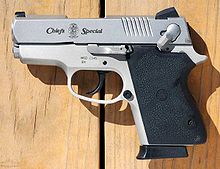
The normal mode of carrying an SA semi-automatic pistol is Condition 1, popularly known as cocked and locked (see photo of Springfield Armory M1911A1 above). Condition 1 (a term popularized by Colonel Jeff Cooper) refers to having the magazine full, a round chambered, the hammer fully cocked, and the thumb safety engaged or on, at least for right-handed users. For many single-action, semi-automatic pistols, this procedure works well only for right-handed users, as the thumb safety is located on the left side of pistol and is easily accessible only for those who are holding the pistol in the right hand.
On many SA semi-automatic pistols, there is also a hammer position known as "half-cocked". Squeezing the trigger will not fire the gun when it is in the half-cocked position, and neither will dropping the gun in this state cause an accidental discharge. During WWII in the Pacific Theater, an unofficial and unapproved carry mode for the SA M1911 by left-handed US soldiers in combat was carrying the gun with the magazine full, a round chambered, the action in half-cocked position, and the thumb safety (accessible only to right-handed users) positioned in the off (or ready-to-fire) mode.
semi-automatic pistol
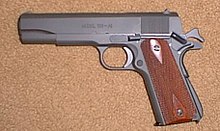
Typically, the first round is manually loaded into the chamber by pulling back and releasing ("racking") the slide mechanism. After the trigger is pulled and the round is fired, the recoil operation of the handgun automatically extracts and ejects the shell casing and reloads the chamber. This mode of operation generally allows for faster reloading and storing a larger number of cartridges than a revolver, although semi-automatic pistols are potentially more prone to malfunctions than revolvers due to their more complex design and mechanism.
Ruger P series
 The Ruger P series are a line of centerfire semi-automatic pistols made by Sturm, Ruger & Company. The P series pistols were designed for military, police, civilian self defense and recreational use. The designs are largely based on the Browning action found in the M1911 pistol, but with minor variations, generally related to the safety mechanism and the barrel-camblock interface. Reviews have considered them rugged, reliable, and strong, though this strength comes at the price of bulk and a blocky appearance.
The Ruger P series are a line of centerfire semi-automatic pistols made by Sturm, Ruger & Company. The P series pistols were designed for military, police, civilian self defense and recreational use. The designs are largely based on the Browning action found in the M1911 pistol, but with minor variations, generally related to the safety mechanism and the barrel-camblock interface. Reviews have considered them rugged, reliable, and strong, though this strength comes at the price of bulk and a blocky appearance.
pocket pistol

A pocket pistol is an American term for any small, pocket-sized semi-automatic pistol or, less-popular, any other handgun (e.g., derringer, or small revolver) of (most commonly) small caliber, suitable for concealed carry in either a front or rear pocket of a pair of trousers, or in an exterior coat pocket. Some consider the term solely applicable to handguns that are striker-fired in semi-automatic configurations.[1] However, with the advent of newer and smaller double action only semi-automatic pistol designs, some locked breech concealed-hammer pistol designs are now also called pocket pistols.
In general use, the term pocket pistol is not considered a pejorative term. However, some pocket pistols, often those of lesser caliber, are referred to as , which sometimes is considered a pejorative term among those who prefer larger caliber pistols, although not among those who prefer smaller caliber and better made pistols for deeper concealment.
Beretta 3032 Tomcat
Beretta 950 Jetfire semi-automatic pistols

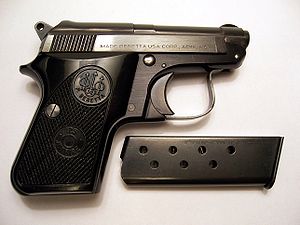 The Beretta 950 Jetfire is a semi-automatic pistol designed and manufactured by Beretta since 1952. It builds on a long line of small and compact pocket pistols manufactured by Beretta for self-defense. Based on very early Beretta models, the weapon is intended to be a very simple and reliable pocket pistol.
The Beretta 950 Jetfire is a semi-automatic pistol designed and manufactured by Beretta since 1952. It builds on a long line of small and compact pocket pistols manufactured by Beretta for self-defense. Based on very early Beretta models, the weapon is intended to be a very simple and reliable pocket pistol.
Osa (pistol)
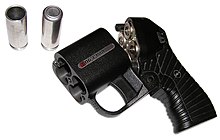
Osa is a multifunctional system of civil non-lethal weapons, designed for the active self-defense, signals and lighting areas. The complex consists of the gun and various versions of the (2-4 cartridges, laser target pointer, electronic ignition capsule) and various ammunition types
A set of consists of four types of cartridges, intended for self-defense (and traumatic), the filing signals[disambiguation needed] and coverage areas. Traumatic cartridge 18 × 45T equipped rubber bullet, 18 × 45SZ - special charge, providing an extremely loud and bright shot, a signal light 18h45S and 18 × 45O - special flashes of various colors and form. The pistol launcher itself is generating an electric pulse to trigger gunpowder charge.
The traumatic cartridge contains a (11.6 g) 15,3 mm bullet, made of rubber and having a metal reinforcing core. This a bullet has an initial speed of about 120 m / s and a muzzle energy of about 85 J. According to the developers, the bullet causes a shock when it hits the target.
Kimber Custom Stainless II pistols

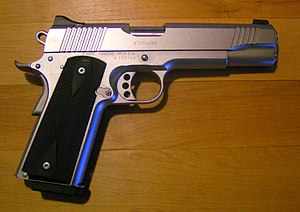 Kimber is known for its highly accurate M1911-style pistols, as well as for offering a variety of customization options. Early on, the company introduced the use of metal injection molding for some parts, such as the thumb safety, which makes them more cost-effective to produce. The adoption of CAD and CAM technology were a priority due to the tight dimensions and low tolerances involved in producing firearms that are designed to be both accurate and reliable. In 2005, Kimber manufactured 47,820 production handguns.
Kimber is known for its highly accurate M1911-style pistols, as well as for offering a variety of customization options. Early on, the company introduced the use of metal injection molding for some parts, such as the thumb safety, which makes them more cost-effective to produce. The adoption of CAD and CAM technology were a priority due to the tight dimensions and low tolerances involved in producing firearms that are designed to be both accurate and reliable. In 2005, Kimber manufactured 47,820 production handguns.


